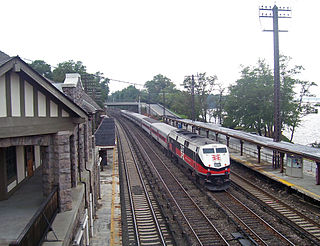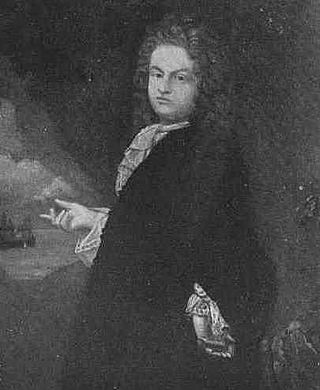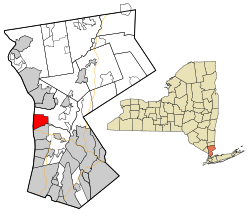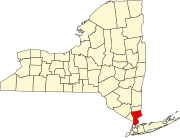
Westchester County is located in the U.S. state of New York. It is the seventh most populous county in the State of New York and the most populous north of New York City. According to the 2020 United States Census, the county had a population of 1,004,456, its highest decennial count ever and an increase of 55,344 (5.8%) from the 949,113 counted in 2010. Westchester covers an area of 450 square miles (1,200 km2), consisting of six cities, 19 towns, and 23 villages. Established in 1683, Westchester was named after the city of Chester, England. The county seat is the city of White Plains, while the most populous municipality in the county is the city of Yonkers, with 211,569 residents per the 2020 census. The county is part of the Hudson Valley region of the state.

Sleepy Hollow is a 1999 gothic supernatural horror film directed by Tim Burton. It is a film adaptation loosely based on Washington Irving's 1820 short story "The Legend of Sleepy Hollow", and stars Johnny Depp and Christina Ricci, with Miranda Richardson, Michael Gambon, Casper Van Dien, Christopher Lee and Jeffrey Jones in supporting roles. The plot follows police constable Ichabod Crane (Depp) sent from New York City to investigate a series of murders in the village of Sleepy Hollow by a mysterious Headless Horseman.

"The Legend of Sleepy Hollow" is an 1820 short story by American author Washington Irving, contained in his collection of 34 essays and short stories titled The Sketch Book of Geoffrey Crayon, Gent. Irving wrote the story while living in Birmingham, England.

Tarrytown is a village in the town of Greenburgh in Westchester County, New York. It is located on the eastern bank of the Hudson River, approximately 25 miles (40 km) north of Midtown Manhattan in New York City, and is served by a stop on the Metro-North Hudson Line. To the north of Tarrytown is the village of Sleepy Hollow, to the south the village of Irvington and to the east unincorporated parts of Greenburgh. The Tappan Zee Bridge crosses the Hudson at Tarrytown, carrying the New York State Thruway to South Nyack, Rockland County and points in Upstate New York. The population was 11,860 at the 2020 census.

Philipse Manor station is a commuter rail stop on the Metro-North Railroad's Hudson Line, located in the Philipse Manor area of Sleepy Hollow, New York, United States.

Wolfert Acker (1667–1753) was a colonial-period American who is featured in Washington Irving's short story collection Wolfert's Roost and Miscellanies (1855). His name was recorded in all combinations of Wolfert or Wolvert as given name, and Acker, Echert, Eckar, or Ecker as surname. He was born in Flatbush, Brooklyn, New York and died at his sizable home, "Wolfert's Roost" near the site of what is now Irvington, New York in Westchester County, New York. On December 20, 1692, on land belonging to Frederick Philipse, he married Maretje Sibouts.

Sunnyside (1835) is an historic house on 10 acres along the Hudson River, in Tarrytown, New York. It was the home of the American author Washington Irving, best known for his short stories, such as "Rip Van Winkle" (1819) and "The Legend of Sleepy Hollow" (1820).

Philipsburg Manor House is a historic house in the Upper Mills section of the former sprawling Colonial-era estate known as Philipsburg Manor. Together with a water mill and trading site the house is operated as a non-profit museum by Historic Hudson Valley. It is located on US 9 in the village of Sleepy Hollow, New York.
Philipse Manor may refer to:

The Old Dutch Church of Sleepy Hollow (Dutch: Oude Nederlandse Kerk van Sleepy Hollow), listed on the National Register of Historic Places as Dutch Reformed Church (Sleepy Hollow), is a 17th-century stone church located on Albany Post Road (U.S. Route 9) in Sleepy Hollow, New York, United States. It and its three-acre (1.2 ha) churchyard feature prominently in Washington Irving's 1820 short story "The Legend of Sleepy Hollow". The churchyard is often confused with the contiguous but separate Sleepy Hollow Cemetery.

Frederick Philipse, first Lord of the Manor of Philipseborough and patriarch of the Philipse family, was a Dutch immigrant to North America of Bohemian heritage. A merchant, he arrived in America as early as 1653. In 1662, he married Margaret Hardenbrook de Vries, a wealthy and driven widow. Together, and variously in league with slavers, pirates, and other undesirables alongside the prominent and respectable, the couple amassed a fortune.

Pocantico Hills is a hamlet in the Westchester County town of Mount Pleasant, New York, United States.
Historic Hudson Valley is a not-for-profit educational and historic preservation organization headquartered in Tarrytown, New York. The organization runs tours and events at five historic properties in Westchester County, in the lower Hudson River Valley.

Philipsburg Manor was a manor located north of New York City in Westchester County in the Province of New York. Netherlands-born Frederick Philipse I and two partners made the initial purchase of land that had been part of a Dutch patroonship owned by Adriaen van der Donck. Philipse subsequently bought his partners out and added more land before being granted a royal charter in 1693 for the 52,000 acres (21,000 ha) estate, becoming its first lord.

Philipse Manor Hall State Historic Site is a historic house museum located in the Getty Square neighborhood of Yonkers, New York. Originally the family seat of Philipse Manor, it is Westchester County's second oldest standing building after the Timothy Knapp House. Located near the Hudson River at Warburton Avenue and Dock Street, it is owned and operated by the New York State Office of Parks, Recreation and Historic Preservation.

The Pocantico River is a nine-mile-long (14 km) tributary of the Hudson River in western central Westchester County, New York, United States. It rises from Echo Lake, in the town of New Castle south of the hamlet of Millwood, and flows generally southwest past Briarcliff Manor to its outlet at Sleepy Hollow. Portions of the towns of Mount Pleasant and Ossining are within its 16-square-mile (41 km2) watershed.
There are numerous nationally and locally designated historic sites and attractions in Westchester County. These include architecturally significant manors and estates, churches, cemeteries, farmhouses, African-American heritage sites, and underground railroad depots and waystations. There are sites from pre-Revolutionary and Revolutionary times, as well as battlegrounds. Westchester County also played an important role in the development of the modern suburb, and there are many associated heritage sites and museums.

Frederick Philipse II was a merchant, landowner, and politician in British America. He was the only son of Maria Sparkes, daughter of the Governor of Barbados, and Philip Philipse, eldest son of Frederick Philipse I, 1st Lord of the Philipsburg Manor. Philip predeceased his father, and family lands passed on to younger son Adolphus Philipse. Upon his uncle's death Frederick II inherited his share of Philipse lands and commercial interests, thereafter becoming the elder Philipse male and 2nd Lord of Philipsburg Manor.
The Hudson Valley Writer Center is a non-profit literary arts organization in Philipsburg Manor, Sleepy Hollow, NY. It was established on August 5, 1988, by Margo Taft Stever, a Sleepy Hollow poet, with the assistance of the Westchester Council of Arts, and moved into its permanent home at the Philipse Manor Railroad Station in 1996. The center hosts over 40 readings by poets, fiction and non-fiction authors, and playwrights over the course of a year, as well as popular recurring monthly events like Open Mic. They also offer workshops and guest readings and publish chapbooks annually under its imprint, Slapering Hol Press.
Sleepy Hollow High School (SHHS) is a high school located in Sleepy Hollow, Westchester County, New York. It is part of the Union Free School District of Tarrytowns. The mascot is the Headless Horseman. It is consistently ranked in the top 5-10% of high schools in New York State. Its diverse student body is reflective of the village's wide array of cultures, socioeconomics, and inclusiveness and is often recognized for excellence in this regard.























